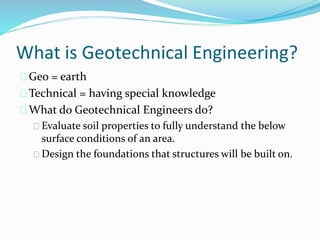The Buzz on Geotheta

A geotechnical designer is a specialized civil engineer that focuses on the actions of dirt, rock, and other products discovered underneath the Earth's surface. They use clinical principles and design methods to examine the properties and habits of these products to sustain the secure and effective style, building, and upkeep of infrastructure tasks.
They carry out website examinations, gather samples, do research laboratory tests, and assess data to assess the suitability of the ground for building and construction projects - Geotechnical Engineers. Based on their searchings for, geotechnical designers give recommendations for foundation layout, slope stability, maintaining frameworks, and mitigation of geotechnical hazards. They work together with various other specialists, such as engineers, architectural engineers, and building groups, to guarantee that geotechnical factors to consider are integrated into the overall task design and execution
By evaluating the habits and buildings of soil and rock, they can recognize prospective geotechnical hazards such as landslides, dirt settlement, or incline instability. Their knowledge helps avoid failures or accidents that could threaten lives and home. Below are some in-depth duties and responsibilities of a geotechnical designer: Website Investigation: Geotechnical engineers conduct site investigations to gather information on subsurface conditions.
They translate the data to comprehend the homes and actions of the dirt and rock, including their stamina, permeability, compaction characteristics, and groundwater conditions. Geotechnical Analysis and Layout: Geotechnical engineers analyze the data accumulated during site investigations to assess the stability and suitability of the website for building and construction tasks. They do geotechnical estimations and modeling to examine variables such as bearing ability, negotiation, slope security, side earth pressures, and groundwater flow.
What Does Geotheta Mean?
Foundation Style: Geotechnical engineers play a vital function in making structures that can safely support the designated structure. They assess the soil conditions and tons needs to establish the suitable foundation type, such as superficial structures (e.g., footings), deep foundations (e.g (https://www.awwwards.com/geotheta/)., stacks), or specialized methods like dirt improvement. They consider elements such as negotiation limits, bearing capacity, and soil-structure interaction to create ideal structure styles
They assess construction plans, monitor website tasks, and conduct field assessments to validate that the style referrals are complied with. If unanticipated geotechnical problems emerge, they evaluate the situation and offer referrals for removal or changes to the design. Risk Analysis and Mitigation: Geotechnical designers examine geotechnical risks and risks connected with the project website, such as landslides, liquefaction, or soil disintegration.

Collaboration and Communication: Geotechnical engineers work carefully with other specialists associated with a job, such as architects, architectural designers, and building teams. Effective interaction and cooperation are vital to incorporate geotechnical considerations right into the general project layout and building process. Geotechnical designers offer technological knowledge, answer queries, and guarantee that geotechnical requirements are fulfilled.
The Single Strategy To Use For Geotheta
Here are some kinds of geotechnical designers: Structure Designer: Foundation engineers specialize in creating and evaluating foundations for frameworks. They evaluate the soil problems, lots requirements, and site characteristics to figure out one of the most appropriate foundation type and design, such as superficial foundations, deep structures, or specialized methods like stack foundations.
They assess the aspects affecting incline security, such as dirt homes, groundwater conditions, and incline geometry, and establish approaches to prevent slope failings and minimize threats. Quake Designer: Quake designers concentrate on assessing and making frameworks to withstand seismic forces. They assess the seismic risk of a site, review dirt liquefaction possibility, and create seismic layout standards to make certain the safety and security and durability of structures throughout quakes.
They execute area useful link screening, collect samples, and examine the collected data to identify the soil residential or commercial properties, geologic formations, and groundwater problems at a website. Geotechnical Instrumentation Designer: Geotechnical instrumentation engineers focus on surveillance and gauging the habits of soil, rock, and frameworks. They set up and maintain instrumentation systems that monitor factors such as soil negotiation, groundwater degrees, slope motions, and architectural displacements to examine performance and supply early warnings of prospective issues.
Geotheta Fundamentals Explained
They have a tendency to be investigatory people, which indicates they're intellectual, reflective, and analytical. They are curious, methodical, reasonable, analytical, and logical. Some of them are additionally social, meaning they're kind, generous, participating, patient, caring, practical, empathetic, tactful, and pleasant - Tailings Engineer.
In the workplace environment, geotechnical designers utilize specialized software tools to carry out calculations, produce layouts, and examine data. They prepare records, review project requirements, connect with clients and employee, and coordinate project activities. The workplace setting provides a conducive setting for research study, analysis, and collaboration with other professionals associated with the project.
Not known Details About Geotheta
They often visit task websites to conduct website investigations, examine geotechnical problems, and collect information for analysis. These check outs entail traveling to various places, sometimes in remote or tough terrains. Geotechnical designers may perform dirt sampling, conduct examinations, and screen building and construction activities to make certain that the geotechnical aspects of the project are being applied correctly.
Geotechnical engineers additionally work in specialized geotechnical labs. In these centers, they conduct experiments, carry out examinations on dirt and rock samples, and evaluate the design properties of the materials. Geotechnical lab designers function extensively in these atmospheres, handling testing devices, running tools, and tape-recording information. They collaborate with other research laboratory personnel to make sure exact and trustworthy screening outcomes.
Comments on “The Ultimate Guide To Geotheta”